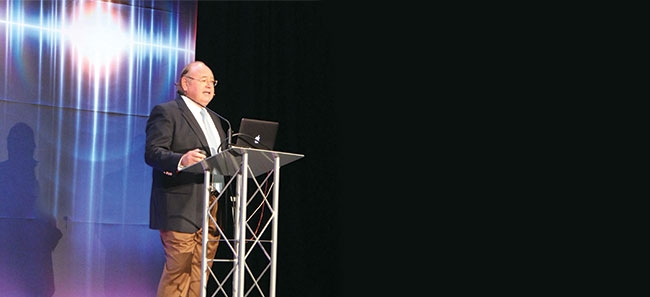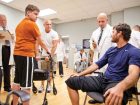
Brain Practice
Mari-Len De
Features Leadership Profession annex chiropractic neurology concussion sidney crosbyChiropractic’s role in managing brain injuries
 During the Wave conference held in San Francisco in August, Dr. Ted Carrick spoke about functional neurology and its role in managing brain dysfunctions. Photo credit: Mari-Len De Guzman
During the Wave conference held in San Francisco in August, Dr. Ted Carrick spoke about functional neurology and its role in managing brain dysfunctions. Photo credit: Mari-Len De GuzmanMost people know Dr. Ted Carrick as the chiropractic neurologist who helped Canadian hockey star Sidney Crosby get back on the ice after suffering severe post-concussion syndrome. What some may not realize, however, is that Carrick’s work and the successes he’s had on patients with brain disorders date back decades before Crosby even walked into his clinic.
Carrick specializes in chiropractic neurology, an area that focuses on the assessment and treatment of brain disorders but without the use of pharmaceuticals or surgery. Instead, this Canadian-born doctor says treatment protocols involve the use of a variety of technology for diagnostic and measurement, vestibular therapies and eye exercises aimed at stimulating the brain to address dysfunctions.
Canadian Chiropractor caught up with Carrick in San Francisco, where he addressed more than 2,000 attendees of The Wave conference hosted by Life Chiropractic College West. Following his presentation, Carrick sat down for an exclusive interview with this writer.
Carrick notes the publicity around Crosby’s concussion treatment and his successful return to play consequently raised the profile of chiropractic as a potentially viable alternative for managing sports concussion.
“The take home message is that when patients present to (chiropractors) with these disorders, they really have got to know what they’re doing,” Carrick points out. “We feel very profoundly that any doctor needs to have extra training specifically in (brain injuries).”
Carrick founded the Carrick Institute in Cape Canaveral, Florida, in 1979. Since then, the institute has trained more than 14,000 physicians – including chiropractors – from all over the world.
There is huge potential for chiropractors in the area of brain injury management, says Carrick, who is also a senior research fellow at Bedfordshire Centre for Mental Health Research in association with the University of Cambridge in the U.K.
“With brain injuries, the treatment standards are not with drugs and not with surgery. So the chiropractic paradigm fits nicely into this non-pharmaceutical model.”
Although he has trained thousands of different kinds of doctors around the world, Carrick says chiropractors are “good observers of function and kinesthesis and human motion, so they can catch on to an understanding of a brain-based model.”
Perhaps the biggest impact chiropractors can have – given the appropriate additional training – is in the area of brain injury from concussion. A large number of chiropractic patients in Canada are athletes. In recent years, chiropractors have gained recognition in sports medicine and are now typically a regular member of a sports medical team.
Canadian pro and Olympic athletes and teams come to Carrick’s clinic for treatment of head traumas and concussions, as well as for “performance enhancement” to help prevent a brain injury.
“I really think that it’s important… it’s better if people didn’t have to leave their country or their province or state, that they could go to a doctor in their area, but that hasn’t happened yet,” Carrick says.
A quick search on Carrick Institute’s website shows at least 34 chiropractors in Canada received clinical neurology training under Carrick with a DACNB (diplomate of the American Chiropractic Neurology Board) designation. That’s only a tiny fraction of qualified practitioners against the backdrop of nearly 200,000 cases of serious brain injuries that occur in Canada every year.
The demand is clearly there, but health practitioners need to be able to confidently and effectively care for and manage these patients.
“The worst thing is to take cases that you’re really not competent in and then fail,” Carrick says. “The majority of treatment for concussions is not very good – this is not a chiropractic paradigm – it’s just not good. Most of them get better on their own, but the ones that go from doctor to doctor to doctor, you need to have a little more skills to address that.”
Because thousands of cases are referred to Carrick for consult every month, he and his team can only see and accommodate a fraction of them. An independent jury helps Carrick evaluate each case and determine those that they can see and treat.
The severity of the patient’s suffering is an important consideration when making decisions on which patients to accept at the clinic. Someone who can’t get out of bed or perform normal functions, for example, would take a higher priority over an individual who can walk without assistance and drive a car, Carrick explains. A young student in high school would take priority over an adult; a mother with children may be selected over someone who is single.
Those cases that Carrick isn’t able to accept are referred to Carrick Institute-trained board-certified doctors for consult and treatment.
Adjusting perceptions
Carrick explains while chiropractors can play an important role in neurological rehab and the management of brain disorders, chiropractic adjustments must be applied at the right time to achieve optimal effect.
He compares the treatment of a brain injury to an ACL repair in the knee. Even though the bandages and the stitches have been removed, the patient will not be running any marathons right away, but would have to undergo retraining of the leg and knees to gradually get back to optimal level.
The same thing happens with a patient’s neck that has had mechanical problems for a period of time, Carrick explains. It is likely the patient would have muscle changes as a result of that mechanical problem. “If you don’t affect the soft tissue stabilization before the adjustment, then you’re going to have to give them another (adjustment), and another one – and so sometimes things just don’t work out so well.”
In cases when a chiropractic adjustment is called for, however, the results can be very powerful and instantaneous, he adds.
“Chiropractic adjustments are central to many things that we do, but we find they’re very profound – they have a big influence. When you have somebody that’s had a brain injury and things are not working so very well, that input (adjustment) can be too much if it is delivered at the wrong time,” Carrick explains.
Neuro focus
Although he now considers Florida his home, Carrick was born and raised in Winnipeg. He earned his chiropractic degree from CMCC in Toronto, and from then went on to accumulate a list of other titles and designations to follow his name: a PhD degree; a global clinical scholar at Harvard Medical School; faculty scholar at Harvard Macy Institute; master of science in health professions education also at Harvard Macy and Massachusetts General Hospital Institutes; and fellowships in neuro-otology, vestibular rehabilitation and EEG – to name a few.
Fredericks has also co-authored several papers in various journals. The most recent one published August 22 in Frontiers in Neurology was titled, “Head–Eye Vestibular Motion Therapy Affects the Mental and Physical Health of Severe Chronic Postconcussion Patients,” a retrospective clinical chart review.
His long list of credentials in the scientific studies and the even longer list of patient referrals to his clinic is why Carrick is not bothered by detractors who claim his success outcomes are placebo or that his clinical approach is not backed by any existing research. He says the consistent, successful patient outcomes and the patient lives that have been positively changed are more important than what critics might say.
The patients who are referred to Carrick are some of the most difficult neuro cases, a large majority of which are sent his way by doctors and neurologists from medical institutions and university hospitals across the globe. For instance, he has patients that came all the way from Australia and the Philippines with postural orthostatic tachycardia syndrome (POTS), and they’ve had great treatment results.
“I think now there is a lot of research showing the efficacy of chiropractic in the non-musculoskeletal types of syndrome,” Carrick notes.
“At the end of the day, you’re not going to get referrals if your outcomes aren’t great. We use the same diagnostic tools that everyone else does,” he adds.
Patients from all over the world who are referred to the Carrick Institute are seen at the Plasticity Brain Centre in Orlando. The centre is run by neuroscience specialists and board-certified experts in neurological rehabilitation – and they are all chiropractic neurologists.
Technology is a big part of Carrick’s assessment and treatment protocols. Diagnostic measurements are standardized to gain consistent outcomes.
“We’ve developed some pretty robust technology specific to human rehabilitation, specifically brain activity.” Carrick explains. “For instance, when people get a stroke, 80 per cent of them never get their arm function back. We do marvelous with that, but we need to have the technology to do it. You can’t have a therapist doing the things that a robot can do.”
Back in Canada
Five years ago, Dr. Jason Whittaker began seeing brain injury cases at his clinic in Winnipeg after completing his post-graduate training at the Carrick Institute and receiving his DACNB certification. Today, his practice has been solely focused on neuro cases.
He says he has always been interested in the relationship between the spine and the nervous system and how chiropractic manipulation influences them. A graduate of CMCC, Whittaker has always had a passion for learning and applying those learning to his clinical practice.
“I just felt that in normal everyday chiropractic practice that something was missing,” Whittaker recalls. “Yes, we’ve had successful patients and we treat the MSK portion of it, but I felt like success would be limited in a way because there are other pieces of the picture that needed to be filled in.”
Whittaker is one of only about 34 chiropractors in Canada who are trained in clinical neurology at the Carrick Institute with a DACNB designation.
Majority of the patients he sees are head trauma cases caused by sports injuries. Whittaker finds he is now also seeing more car accident-related trauma cases, since his practice was officially designated by Manitoba Public Insurance as a head trauma specialist.
In addition to sports injuries and vehicular accident cases, Whittaker also receives referrals for movement disorders such as dystonia, as well as post-stroke rehab, dizziness, vertigo and other balance disorders, helping patients toward functional recovery.
“A lot of my patients come from other chiropractors and other health-care professionals because there is a need there. There is a niche for neurorehabilitation and helping people with these types of conditions,” Whittaker says.
Like Carrick, Whittaker believes there is significant potential for chiropractors – with a keen interest in brain functions – to expand their skillsets and knowledge toward functional neurology.
The focus on musculoskeletal conditions is a significant area of practice for chiropractors – but the benefits of chiropractic can go way beyond just the MSK realm, Whittaker notes.
“I don’t want us to drop the ‘n’ – which is the ‘neuromusculoskeletal.’ There is so much influence above the spine with how the spine functions – you can’t separate them,” he says.
In the U.S., where this specialty is officially recognized, Whittaker would be designated a chiropractic neurologist. However, this designation is not yet recognized in Canada as an official chiropractic specialty. Although it would be nice to have his specialty recognized in his own country, Whittaker says it’s not really a big deal, as long as colleagues within the profession and in other health-care practices are aware that he has specialized training in functional neurology and that they can refer these types of cases to him.
It’s all about inter- and intraprofessional collaboration.
“I think it should be more well-known within the profession of who the specialists are and what skillsets they have so we can share among each other and help each other out with a patient,” Whittaker says.
Mari-Len De Guzman is the editor of Canadian Chiropractor magazine. Email her at mdeguzman@annexweb.com.
Print this page

